Gangster
Author: Thorsten Gimmler
Publisher: Amigo
Year: 2007
review by

| x |
|
|
|
|
|
|
|
|
|
|
|
|
|
|
|
|
|
|
|
|
|
|
|
|
|
|
|
|
|
|
|
|
|
|
|
|
|
|
|
|
|
|
|
|
|
 |
Chicago 1930, it is a corrupt and criminal city. Officers who are bribed turn a blind eye on some dirty business, and the police force even looks the other way when crimes are committed. And this only to let the local gangsters continue to go their own way. Here a bomb explodes, there a body floats in the water. The illegal earned money is put into the legal circuits of bars, night clubs and neatly looking shops. But respected lawyers also participate in this game for money and power as a mafia mate without even a blush, and deceitful esate agents and, erh, wait, we are still speaking about Chicago 1930, right? |
| x |
|
|
|
|
|
|
|
|
|
|
|
|
|
|
|
|
|
|
|
|
|
|
|
|
|
|
|
|
|
|
|
|
|
|
|
|
|
|
|
|
|
|
|
|
|
| In Chicago, the command over the various quarters has to be gained or defended, and all means are permitted, of course; the harbour is near, and the fish don’t talk...The two to five players place their gangsters in order to secure the profitable revenues of the various quarters. With a car they drive through the city to drop their gangsters in the quarters, and pick up an occasional enemy and put it in the trunk to drive to the harbour to dispose this problem. At the end of three rounds will be clear who of the gangster mobs has been the most succesful in gaining their command over the city. |
|
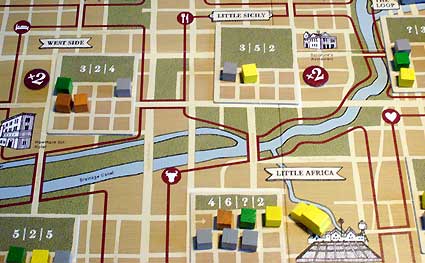 |
| x |
|
|
|
|
|
|
|
|
|
|
|
|
|
|
|
|
|
|
|
|
|
|
|
x |
|
|
|
|
|
|
|
|
|
|
|
|
|
|
|
|
|
|
|
|
|
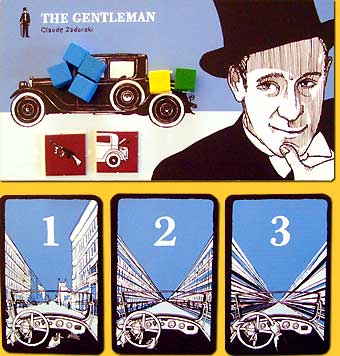 |
Each player has his own player board with his character depicted, together with an illustration of the car that already is loaded with some gangsters. He also has three movement cards, from one to three. A wooden car is placed in one of the quarters on the board. The quarters have been supplied with cards that have various capacity and revenues, important for scoring at the end of a round. Some initial gangsters already have been placed on the board. |
| x |
|
|
|
|
|
|
|
|
|
|
|
|
|
|
|
|
|
|
|
|
|
|
|
x |
|
|
|
|
|
|
|
|
|
|
|
|
|
|
|
|
|
|
|
|
|
| All players are supplied with an extra: there are six different ‘expansion’ chits, from a body guard who protects your gangsters in a quarter against an enemy pick up or a tommy gun that enables a pick up in an adjacent quarter, to an extra large trunk with space for two instead of one gangster. When an opposing gangster is dumped in the harbour, then it is removed from the game. Also in the harbour is a set of three expansion chits, one of which a player then has to take. He only has room for two of those chits, so with the acquisition of a third he will have to remove the rightmost expansion. |
|
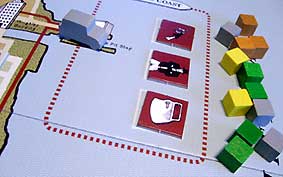 |
| x |
|
|
|
|
|
|
|
|
|
|
|
|
|
|
|
|
|
|
|
|
|
|
|
x |
|
|
|
|
|
|
|
|
|
|
|
|
|
|
|
|
|
|
|
|
|
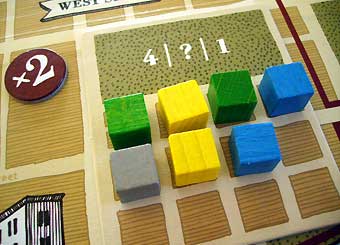 |
In a turn a player chooses between moving, get in the car or get out. I fhe chooses for moving, he plays one of the movement cards, the played number being the amount of quarters he can travel with his car. The card is turned upside down and only available until all three cards have been played.
Each time a player turns his cards face up again, a card from a quarter deck is turned face up. If it shows one of the quarters, a double value marker is placed in that quarter; this quarter scores double at the end of the round. If the card shows a police officer, nothing happens.
|
| x |
|
|
|
|
|
|
|
|
|
|
|
|
|
|
|
|
|
|
|
|
|
|
|
|
|
|
|
|
|
|
|
|
|
|
|
|
|
|
|
|
|
|
|
|
|
| If a player chooses to get out, he takes a gangster from his player card and puts it on the first free spot in the quarter where his wooden car is. Gangsters who come in last have the oldest rights, oddly enough, so when tied this gangster gets the higher value when scoring at the end of a round. For this the action loading of a gangster comes in quite handy, that allows a player to get in one of his gangsters, or take an opposing one and put it in his trunk. This leaves a quarter with open spaces that only get taken again only until the last position of a quarter has been occupied. |
| x |
|
|
|
|
|
|
|
|
|
|
|
|
|
|
|
|
|
|
|
|
|
|
|
|
|
|
|
|
|
|
|
|
|
|
|
|
|
|
|
|
|
|
|
|
|
 |
| x |
|
|
|
|
|
|
|
|
|
|
|
|
|
|
|
|
|
|
|
|
|
|
|
|
|
|
|
|
|
|
|
|
|
|
|
|
|
|
|
|
|
|
|
|
|
|
When the eighth double marker has been placed, a round ends and all quarters are scored according to the values on the quarter cards. Some cards have a question mark for a position. A card from the casino deck will reveal what this position will score, from a scanty ‘1’ to a profitable ‘6’ points.
Preparations for a following round include a fresh group of gangsters, and removal of the double markers. Unplaced gangsters from a previous round are taken into the new round. After the third round the player with the most points wins.
|
| x |
|
|
|
|
|
|
|
|
|
|
|
|
|
|
|
|
|
|
|
|
|
|
|
|
|
|
|
|
|
|
|
|
|
|
|
|
|
|
|
|
|
|
|
|
|
| x |
|
|
|
|
|
|
|
|
|
|
|
|
|
|
|
|
|
|
|
|
|
|
|
|
|
|
|
|
|
|
|
|
|
|
|
|
|
|
|
|
|
|
|
|
|
| x |
|
|
|
|
|
|
|
|
|
|
|
|
|
|
|
|
|
|
|
|
|
|
|
|
|
|
|
|
|
|
|
|
|
|
|
|
|
|
|
|
|
|
|
|
|
 |
|
|
|
|
|
|
|
|
|
|
|
|
|
|
x |
|
|
|
|
|
|
|
|
|
|
|
|
|
|
|
|
|
|
|
|
|
|
|
|
|
|
|
All is about majorities, and sometimes avoiding them, when in a quarter the first position scores lower than a second or third one. Yet it happens very often that a player who manages to shirks from the quarrel and keeps working on his steady presence on the board, scores the best.
Driving to the harbour in between to dispose an opposing gangster seems a nice revenge but is loss of energy better put to action in placing additional gangsters.
|
|
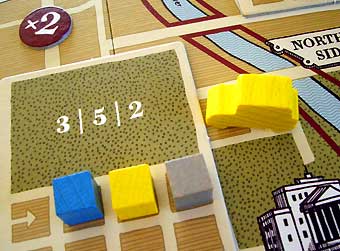 |
| x |
|
|
|
|
|
|
|
|
|
|
|
|
|
|
|
|
|
|
|
|
|
|
|
|
|
|
|
|
|
|
x |
|
|
|
|
|
|
|
|
|
|
|
|
|
|
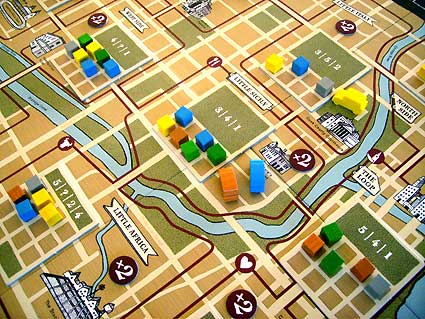 |
|
The rule that opens spaces in a quarter do not get filled only after the quarter is full, is weird and seems redundant as it almost never occurs.
The game can be played by two players, but each of them will have to play with two colours, and this feels like a fraud. This way every game can be played with two players! This condition let players act like schizofrenics, at one time thinking for blue, the other time for yellow. No, ‘Gangster’ is not for two players, not with this gimmick.
|
| x |
|
|
|
|
|
|
|
|
|
|
|
|
|
|
|
|
|
|
|
|
|
|
|
|
|
|
|
|
|
|
|
|
|
|
|
|
|
|
|
|
|
|
|
|
|
| Then there is something else that is weird: the double markers. These are put in eight of the ten quarters. So each round there are two quarters that, quite random, are not doubled in their score. This occasionaly leads to very unfair results for a player. We want to plan, but we can’t. |
| x |
|
|
|
|
|
|
|
|
|
|
|
|
|
|
|
|
|
|
|
|
|
|
|
|
|
|
|
|
|
|
|
|
|
|
|
|
|
|
|
|
|
|
|
|
|
| That the quarters in each new play of Chicago are covered with loose scoring cards, seems a nice variation - o nice! each time a different game! - but it also arises another, general question for games with variables like this: is the author or publisher afraid to deliver a game with a preprinted score on the board, maybe out of fear the game might get broken by intensive play, revealing a winning tactics; so in fact leaving us with an imperfect game? Maybe this is not so, but it would give a more powerful statement when the author/publisher would choose for us: this is the (intensively playtested) game, and not: here is your many-games-in-a-box, this is possible, but that is also possible, and have a good time with it... |
|
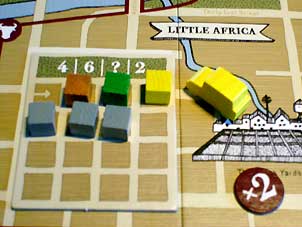 |
| x |
|
|
|
|
|
|
|
|
|
|
|
|
|
|
|
|
|
|
|
|
|
|
|
|
|
|
|
|
|
|
|
|
|
|
|
|
|
|
|
|
|
|
|
|
|
The game suffices, but doesn’t move a lot. Each player shuffles with his car a bit, and loads or unloads a cube. Three rounds of this and one and a half hour of playing time is just too much; the game does not captivate. We like majority games, we do, but instead we like to play ‘El Grande’: exciting and swift, played in just over an hour.
© 2008 Richard van Vugt
Gangster, Thorsten Gimmler, Amigo, 2007 - 2 to 5 players, 10 years and up, 90 minutes
|
  |
|
|
|
|
|
|
|
|
|
|
|
|
|
|
|
|
|
|
|
|
|
|
|
|
|
|
|
|
|
|
|
|
|
|
|
|
|
|
|
|
|
  |
|
|
|
|
|
|
|
|
|
|
|
|
|
|
|
|
|
|
|
|
|
|
|
|
|
|
|
|
|
|
|
|
|
|
|
|
|
|
|
|
|
  |
|
|
|
|
|
|
|
|
|
|
|
|
|
|
|
|
|
|
|
|
|
|
|
|
|
|
|
|
|
|
|
|
|
|
|
|
|
|
|
|
|
  |
|
|
|
|
|
|
|
|
|
|
|
|
|
|
|
|
|
|
|
|
|
|
|
|
|
|
|
|
|
|
|
|
|
|
|
|
|
|
|
|
|
  |
|
|
|
|
|
|
|
|
|
|
|
|
|
|
|
|
|
|
|
|
|
|
|
|
|
|
|
|
|
|
|
|
|
|
|
|
|
|
|
|
|
  |
|
|
|
|
|
|
|
|
|
|
|
|
|
|
|
|
|
|
|
|
|
|
|
|
|
|
|
|
|
|
|
|
|
|
|
|
|
|
|
|
|
| x |
|
|
|
|
|
|
|
|
|
|
|
|
|
|
|
|
|
|
|
|
|
|
|
|
|
|
|
|
|
|
|
|
|
|
|
|
|
|
|
|
|
|
|
|
|
| x |
|
|
|
|
|
|
|
|
|
|
|
|
|
|
|
|
|
|
|
|
|
|
|
|
|
|
|
|
|
|
|
|
|
|
|
|
|
|
|
|
|
|
|
|
|
 |
|
|
|
|
|
|
|
|
|
|
|
|
|
|
|
|
|
|
|
|
|
|
|
|
|
|
|
|
|
|
|
|
|
|
|
|
|
|
|
|
|
 |
|
|
|
|
|
|
|
|
|
|
|
|
|
|
|
|
|
|
|
|
|
|
|
|
|
|
|
|
|
|
|
|
|
|
|
|
|
|
|
|
|
| x |
|
|
|
|
|
|
|
|
|
|
|
|
|
|
|
|
|
|
|
|
|
|
|
|
|
|
|
|
|
|
|
|
|
|
|
|
|
|
|
|
|
|
|
|
|
 |
|
|
|
|
|
|
|
|
|
|
|
|
|
|
|
|
|
|
|
|
|
|
|
|
|
|
|
|
|
|
|
|
|
 |
|
|
|
|
|
|
|
|
|
|
|
|
|
|
|
|
|
|
|
|
|
|
|
|
|
|
|
|
|
|
|
|
|
|
|